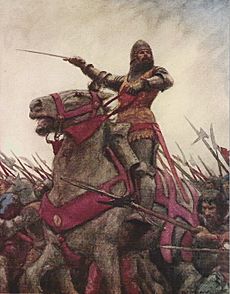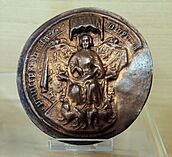Owain Glyndŵr facts for kids
Quick facts for kids Owain Glyndŵr |
|
|---|---|
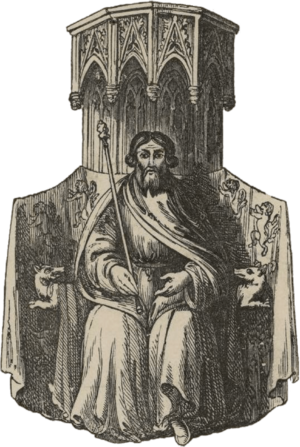
Portrait of Owain Glyndŵr from his great seal
|
|
| Baron of Glyndyfrdwy, and Lord of Cynllaith Owain | |
| Reign | c. 1370-1400 |
| Predecessor | Lord Gruffydd Fychan II |
| Successor | Abolished |
| Prince of Wales | |
| Reign | 1400–1415 |
| Predecessor | Welsh: Dafydd ap Gruffydd (1282-1283) English: Henry of Monmouth (1399–1400) |
| Successor | Welsh: Vacant English: Edward of Westminster (1453–1471) |
| Born | Owain ap Gruffydd c. 1354 Sycharth, Wales |
| Died | 20 September 1415 (aged 60–61) |
| Burial | 21 September 1415 (unknown location) |
| Spouse | Margaret Hanmer |
| Issue among others |
|
| House | Mathrafal |
| Father | Gruffudd Fychan II |
| Mother | Elen ferch Tomas ap Llywelyn |
| Signature |  |
Owain Glyndŵr (born around 1354, died September 20, 1415) was a famous Welsh leader. He was a soldier and military commander during the late Middle Ages. Owain led a 15-year-long Welsh revolt to end English rule in Wales.
He was a smart lawyer and even created the first Welsh parliament. Owain was the last Welshman born in Wales to claim the title of Prince of Wales.
In 1400, Owain had a disagreement with an English lord. This argument quickly grew into a huge national revolt. Welsh people and nobles fought against the English army. Because of the rebellion, new laws were made against the Welsh. These laws were unfair and made many more Welsh people support Owain.
By 1404, Owain's forces had won many battles and captured several castles. He controlled most of Wales. His supporters declared him the Prince of Wales. Other European countries, like France, Brittany, and Scotland, sent help. Owain then called the first Welsh parliament in Machynlleth. He shared his plans for Wales, which included building two universities. He also wanted to bring back old Welsh laws and create an independent Welsh church.
The war continued, but over time, the English slowly took back control of Wales. By 1409, Owain's last castles, Harlech and Aberystwyth, were captured. Owain refused to give up. He went into the Welsh hills and mountains with his remaining fighters. He continued to fight using guerrilla tactics. Owain disappeared in 1415, and one of his followers recorded his death.
Owain Glyndŵr was never caught or betrayed, even though there was a large reward for him. In Welsh culture, he became a legendary hero, like King Arthur. He is known as 'The Foretold Son' (Welsh: Y Mab Darogan). In William Shakespeare's play Henry IV, Part 1, he appears as Owen Glendower.
Contents
Owain Glyndŵr's Early Life

Owain Glyndŵr was born around 1354 in Sycharth, North East Wales. He came from a powerful family that had both Welsh and English roots. His father, Gruffydd Fychan II, was the Baron of Glyndyfrdwy. He died around 1370, leaving Owain's mother, Elen, a widow.
Owain was related to all three main Welsh royal families. Through his father, he was an heir to the old Kingdom of Powys. Through his mother, he was related to the royal families of Deheubarth and Gwynedd.
Young Owain probably lived with David Hanmer, a lawyer, or Richard FitzAlan, 3rd Earl of Arundel. He then went to London to study law for about seven years. He might have been in London during the Peasants' Revolt of 1381.
By 1384, Owain was back in Wales. He married Margaret Hanmer, David's daughter, possibly in 1383. They had a large family and Owain became the owner of his family lands at Sycharth and Glyndyfrdwy.
Military Experience
Owain joined the king's army in 1384. He served on the English-Scottish border. In 1385, he served King Richard II in Scotland. In 1386, he gave evidence in a court case in Chester.
In 1387, Owain fought in a naval battle in the English Channel. He helped defeat a French-Spanish-Flemish fleet. After his father-in-law died, Owain returned to Wales. He also served under Henry Bolingbroke (who later became King Henry IV) in a battle in 1387.
From 1384 to 1388, Owain gained a lot of military experience. He saw important events and met important people. After this, he likely returned to his home in Wales and lived quietly for ten years. A Welsh poet named Iolo Goch visited Owain's home and praised his generosity.
Owain Glyndŵr's Welsh Rebellion
Why the Rebellion Started
In the late 1390s, things became difficult for Owain. His neighbor, Baron Grey of Ruthin, took some of his land. Owain asked the English Parliament for help, but they ignored him.
In 1400, Lord Grey did not tell Owain about a royal order to gather soldiers for service in Scotland. This allowed Lord Grey to call Owain a traitor. The courts refused to hear Owain's case. Owain had written an angry letter to Lord Grey, which Lord Grey used against him.
Lord Grey threatened to "burn and slay" Owain's lands. Owain threatened to do the same in return. Lord Grey then said he would take Owain's letter to King Henry IV. He said Owain would be hanged for treason. At this time, there was also unrest in Chester after an officer of the old King Richard II was executed.
The Start of the Revolt
On September 16, 1400, at Sycharth, Owain Glyndŵr declared himself the Prince of Wales. He had about 300 men with him. After this, he started a 15-year rebellion against King Henry IV.
In September and October 1400, the revolt spread across North Wales. Owain and his followers attacked Lord Grey's lands, burning Ruthin. They also attacked Denbigh, Rhuddlan, Flint, Holt, Oswestry, and Welshpool. These were seen as English towns in Wales.
The King of England heard about the revolt and sent for military help. Much of northern and central Wales joined Owain. Owain's army used guerrilla tactics, hiding and then attacking English forces.
The Welsh Rebellion Grows
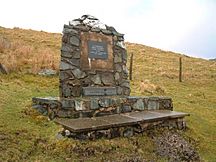
In April 1401, 40 of Owain's men, led by his cousins, captured Conwy Castle. King Henry IV sent Henry Percy (Hotspur) to restore order. The King offered a pardon to all rebels except Owain and his cousins.
In June, Owain won his first big battle at Mynydd Hyddgen. King Henry IV responded by attacking Strata Florida Abbey. The rebellion spread across North Wales. Farmers sold their cattle to buy weapons. Secret meetings were held, and poets spread messages of rebellion.
The King took away Owain's home at Sycharth. By autumn, Gwynedd, Ceredigion, and Powys joined the rebellion. Owain tried to get help from Scotland and Ireland, but the English stopped these efforts.
Between 1401 and 1402, the English Parliament passed unfair laws against the Welsh. These laws were meant to force the Welsh to surrender. Instead, they made more Welsh people angry and join the rebellion.
In 1402, Owain captured his enemy, Baron Grey de Ruthyn. He held him for almost a year until he received a large ransom. In June 1402, Owain defeated an English force led by Sir Edmund Mortimer. Mortimer was captured. King Henry IV refused to pay ransom for Mortimer. Mortimer then made an alliance with Owain and married one of Owain's daughters.
News of the rebellion's success spread. Owain began to get support from Scotland and Brittany. King Charles VI of France also agreed to send French troops and supplies. By 1403, Owain had a large army. A Welsh army, with French help, defeated a large English force led by King Henry IV himself.
In 1403, Prince Henry burned down Owain's homes at Sycharth and Glyndyfrdwy. Owain continued to attack towns and castles. For 10 days in July, he toured south and southwest Wales. All of the south joined the rebellion. This led to an internal rebellion against the King of England.
The revolt became truly national in Wales. Welsh students left Oxford and Cambridge Universities to join Owain. Welsh workers left England and returned to Wales. Hundreds of Welsh archers and experienced soldiers left English service to join the rebellion.
In 1404, Owain's forces took Aberystwyth Castle and Harlech Castle. They then burned Cardiff Castle. A court was held at Harlech, and Gruffydd Young was made the Welsh Chancellor.
Owain Becomes Prince of Wales
By 1404, Owain had stopped four English military attacks. He had strong control over Wales. In 1404, his supporters declared him Prince of Wales (Welsh: Tywysog Cymru). He held parliaments in Machynlleth and Harlech.
Owain planned to build two national universities. He also wanted to bring back the traditional Welsh laws of Hywel Dda. He aimed to create an independent Welsh church. Envoys from France, Scotland, and Spain visited. In 1405, representatives from every part of Wales were sent to Harlech.
The Tripartite Indenture
In February 1405, Owain made an agreement called the Tripartite Indenture. This was with Edmund Mortimer and Henry Percy. They agreed to divide England and Wales among the three of them. Wales would stretch to the Severn and Mersey rivers.
Owain sent Gruffydd Yonge and John Hanmer to talk with the French. This led to a formal treaty. France promised to help Owain and the Welsh. Joint Welsh and French forces then attacked Kidwelly Castle. Scottish and French ships also helped Owain's war.
In 1405, French forces landed in Milford Haven in west Wales. They burned Haverford West and tried to capture Pembroke Castle. The combined French and Welsh forces took Carmarthen. They then marched into Herefordshire and Worcestershire.
Letter to Charles VI of France
By 1405, most French forces had left Wales. On March 31, 1406, Owain wrote a letter to King Charles VI of France. This letter, known as the Pennal Letter, asked for continued military support. In return, Owain would recognize Benedict XIII of Avignon as the Pope.
The letter showed Owain's goals for an independent Wales. He wanted his own parliament, led by himself as Prince of Wales. He also wanted to bring back traditional Welsh law. He aimed to establish an independent Welsh church and two universities. After this letter, many church leaders and important people joined Owain. English resistance was reduced to a few castles and towns.
Owain's Great Seal and a letter he wrote to the French in 1406 are in Paris. The seal from 1404 calls him "Owain, by the grace of God, Prince of Wales."
The Rebellion Weakens

In early 1405, the Welsh forces started to lose battles. Owain's brother, Lord Tudur ap Gruffudd, died in May 1405. English forces landed in Anglesey and slowly pushed the Welsh back. By late 1406, resistance in Anglesey ended.
After years of fighting, Prince Henry changed his strategy. Instead of just punishing the Welsh, he focused on cutting off their trade and weapons. He used castles still under English control to slowly retake Wales. By 1407, this plan was working.
By 1408, the English recaptured Aberystwyth and then Harlech Castle. Harlech surrendered in early 1409. Edmund Mortimer died during the siege. Owain's wife, Margaret, and two of his daughters were captured. They were imprisoned in the Tower of London and died there in 1413. Before his downfall, Owain was considered the wealthiest Welshman.
Owain escaped capture by disguising himself as an old man. He slipped past the English blockade at night. He went into the Welsh wilderness with loyal supporters. He refused to surrender and continued to fight using guerrilla tactics. He launched surprise raids and ambushes.
Owain remained free, but he had lost his home. He continued the rebellion, especially wanting to avenge his wife. In 1410, Owain raided Shropshire. In 1412, he carried out one of his last successful raids. He ambushed the King's men in Brecon and captured Dafydd Gam. This was the last time his enemies saw Owain alive.
King Henry IV died in 1413. His son, Henry V, offered pardons to the rebel leaders. As late as 1414, there were rumors that Owain was communicating with a Lollard leader.
On December 21, 1411, the King of England pardoned all Welsh people except Owain. Owain ignored offers of a pardon many times. His followers continued to be punished. His death was recorded by a former follower in 1415.
Owain's Disappearance
No one knows for sure what happened to Owain after 1412. Even though huge rewards were offered, he was never captured or betrayed. He refused all royal pardons. It is believed he died in 1415, and certainly by 1417.
Adam of Usk, a former supporter, wrote in his Chronicle for 1415: "he was buried at night by his followers. But his burial was detected by his opponents; so he was re-buried. But where his body lies is unknown." Thomas Pennant wrote that Owain died on September 20, 1415, at age 61.
Owain may have spent his last days at Kentchurch in south Herefordshire. This was the home of the Scudamore family. There are many folk tales about Owain using disguises during the rebellion. After his disappearance, some people wondered if the Welsh poet, Siôn Cent, was Owain in disguise.
Where is Owain Buried?
The exact location of Owain's burial is unknown, but there has been much speculation. In 1875, a reverend wrote in his diary that he saw "Owen Glendower's" grave at Monnington on Wye. It was a flat stone near the church porch.
Another idea comes from Adrien Jones, president of the Owain Glyndŵr Society. He said a descendant of Glyndŵr told him that Owain spent his last days and died at Mornington Straddle in Herefordshire. This was a family secret for 600 years. There is even a mound where he is believed to be buried there.
Historian Gruffydd Aled Williams suggested in 2017 that Owain is buried in Kimbolton Chapel near Leominster. This is based on old documents in the National Archives. Kimbolton is connected to the Scudamore family.
Owain's Family
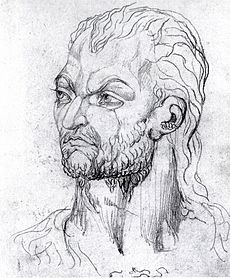
Owain married Margaret Hanmer, also known as Marred ferch Dafydd. They had five or six sons and four or five daughters. Owain also had some children outside of his marriage.
Sons
All of Owain and Margaret's sons either died in battle or were captured and died in prison. They did not have children. Gruffudd was captured and imprisoned in the Tower of London. Maredudd received a royal pardon in 1421 but died a few years later.
Daughters
- Alice (Alys), married John Scudamore
- Jane
- Janet, married Sir John De Croft
- Margaret, married Sir Richard Monnington
- Catherine (Catrin) (died 1413), married Edmund Mortimer
After Owain disappeared, his oldest daughter, Alice, became known as the Lady of Glyndyfrdwy. She successfully went to court in 1431 to get back her family lands. Her descendants married into the Scudamore family. Another daughter, Jane, married Henry, Lord Grey de Ruthin. Janet married into the noble Croft family. Margaret married a knight from Monnington.
Other Children
Owain had other children who were not born within his marriage. These included Ieuan, Myfanwy, and Gwenllian. It is debated if his son David was also born outside of marriage. Ieuan was Owain's only male descendant to have children. These children stayed in Wales and married into local Welsh families.
A Poem About His Family
The poet Iolo Goch wrote about Owain's wife, Margaret:
The best of wives.
Eminent woman of a knightly family,
Her children come in pairs,
A beautiful nest of chieftains.
Owain's Royal Family Connections
Owain Glyndŵr had claims to royal ancestry from all three of the main Welsh royal families: Powys, Deheubarth, and Gwynedd. His claims were clearest for Powys and Deheubarth.
| (Rulers of Powys) | (Rulers of Deheubarth) | (Rulers of Gwynedd) | |||||||||||||||||||||||||||||||||||||||||||||
| Bleddyn ap Cynfyn d. 1075 |
Rhys ap Tewdwr d. 1093 |
Gruffudd ap Cynan | |||||||||||||||||||||||||||||||||||||||||||||
| Maredudd ap Bleddyn d. 1132 |
Gruffudd ap Rhys d. 1137 |
Owain Gwynedd | |||||||||||||||||||||||||||||||||||||||||||||
| Madog ap Maredudd d. 1160 |
Rhys ap Gruffudd (Yr Arglwydd Rhys) d. 1197 |
Iorwerth Drwyndwn | |||||||||||||||||||||||||||||||||||||||||||||
| Gruffudd Maelor I d. 1191 |
Gruffudd d. 1201 |
Llywelyn Fawr | |||||||||||||||||||||||||||||||||||||||||||||
| Madog ap Gruffudd Maelor d. 1236 |
Owain d. 1235 |
Angharad ferch Llywelyn | |||||||||||||||||||||||||||||||||||||||||||||
| Gruffudd Maelor II d. 1269 |
Maredudd ab Owain d. 1265 |
Eleanor | Marared | ||||||||||||||||||||||||||||||||||||||||||||
| Gruffudd Fychan I d. 1289 |
Owain d. 1275 |
Angharad | |||||||||||||||||||||||||||||||||||||||||||||
| Madog Crypl c. 1275 – 1304 |
Llywelyn ab Owain d. 1308 |
||||||||||||||||||||||||||||||||||||||||||||||
| Gruffudd | Tomos d. 1343 |
||||||||||||||||||||||||||||||||||||||||||||||
| Gruffudd Fychan II d. before 1340 |
Elen | ||||||||||||||||||||||||||||||||||||||||||||||
| Owain Glyndŵr c. 1354 – c. 1414 |
|||||||||||||||||||||||||||||||||||||||||||||||
Gwynedd Ancestry
Owain Glyndŵr's ancestors were also from the medieval Kingdom of Gwynedd. He was a descendant of the Gwynedd King Gruffudd ap Cynan (died 1137) through his great-grandmother Gwenllian. Some sources say he was related to Llywelyn ap Iorwerth (Llywelyn I, The Great, died 1240). Other historians say that Llywelyn II (died 1282) was his ancestor. However, Llywelyn II only had one daughter, Gwenllian, who died without children.
Owain's Banners and Coat of Arms
-
The Gold dragon of Wales, a modern image of a flag Owain used.
-
Arms given to Owain Glyndŵr in A Tour in Wales by Thomas Pennant.
Owain Glyndŵr's Legacy
In Welsh culture, Owain Glyndŵr became a legendary figure. He is seen as a folk hero, like King Arthur. He is known as 'The Foretold Son' (Y Mab Darogan). This myth says that one day, a 'Son of Prophecy' will return to free the Welsh people. Owain's claim as Prince of Wales was similar to another distant relative, Owain Lawgoch.
Modern Legacy
- Fidel Castro described Owain Glyndŵr as the first effective guerrilla leader. Some believe Castro and Che Guevara copied some of Owain's methods.
- During the First World War, Prime Minister David Lloyd George unveiled a statue of Owain in Cardiff City Hall.
- A statue of Owain Glyndŵr was put up in Corwen in 1995. In 2007, it was replaced with a larger statue of him on horseback.
- Owain Glyndŵr came second in the 100 Welsh Heroes poll in 2003/2004.
- Stamps with his picture were issued in 1974 and 2008. Streets, parks, and public squares are named after him in Wales.
- There is a campaign to make September 16 (Owain Glyndŵr Day) a public holiday in Wales. This is the date Owain started his rebellion.
- The rugby team RGC 1404 (Rygbi Gogledd Cymru/North Wales Rugby) is named after the year Owain was crowned Prince of Wales.
- A road in Aberystwyth was renamed "Owain Glyndwr Square."
- A monument was built in Machynlleth to celebrate the 600th anniversary of Owain's life.
Meibion Glyndŵr
Today, Owain Glyndŵr is remembered as a national hero. Some groups use his name to support independence for Wales. For example, in the 1980s, a group called Meibion Glyndŵr ("the Sons of Glyndŵr") claimed responsibility for burning English holiday homes in Wales.
Owain in Literature
- After Owain's death, there was little resistance to English rule. In Henry IV, Part 1, Shakespeare shows him as Owen Glendower. He is portrayed as wild and magical.
- It wasn't until the late 1800s that Owain's reputation was revived. The Cymru Fydd ("Young Wales") movement saw him as the father of Welsh nationalism.
- Owain later became a mythical hero. Thomas Pennant wrote about the legends and places connected to Owain in his Tours in Wales.
- Owain has appeared in modern books. These include John Cowper Powys's novel Owen Glendower (1941) and Edith Pargeter's A Bloody Field by Shrewsbury (1972).
- A fictionalized Owain Glyndŵr is in Maggie Stiefvater's book series, The Raven Cycle. In the series, characters believe his body was brought from Wales to Virginia. They think whoever can "wake" him will get a wish.
Namesakes
- The Owain Glyndwr Hotel in Corwen is an old 18th-century inn.
- The Owain Glyndŵr pub in Cardiff is named in his honor.
- The Glyndŵr's Way is a 132-mile walking path in Mid Wales. It runs near his homelands.
- At least two ships and two trains have been named after Owain Glyndŵr:
- In 1808, the Royal Navy launched a ship called HMS Owen Glendower.
- The Owen Glendower was a large sailing ship built in 1839.
- In 1923, a train called "Owain Glyndwr" was built for the Vale of Rheidol Railway. It is still used today.
- A British Railways steam train, 70010 Owen Glendower, was built in 1951.
- In 2002, a plaque was put up near the Tower of London. It remembers Owain's daughter Catrin, who died there with her children.
- From 2008 to 2023, Wrexham University was called Glyndŵr University. The university still has ties with the Owain Glyndŵr Society.
Royal Succession
|
Owain Glyndŵr
Born: 1354 Died: 20 September 1415 |
||
| Peerage of England | ||
|---|---|---|
| Preceded by Gruffydd Fychan II |
Hereditary Lord of Glyndyfrdwy 1369 – c. 1415 |
Succeeded by Maredudd ab Owain Glyndŵr |
| Titles in pretence | ||
|---|---|---|
|
Owain Glyndŵr
|
||
| Preceded by 'Welsh title:' Dafydd ap Gruffudd (1283) English title: Henry V of England (1399-1413) Pretender: Owain Lawgoch (1363/78) |
— TITULAR — Prince of Wales 1400 – c. 1415 |
Succeeded by Edward of Westminster, Prince of Wales (1453 – 1471) |
See also
 In Spanish: Owain Glyndŵr para niños
In Spanish: Owain Glyndŵr para niños
- Buildings associated with Owain Glyndŵr
- Welsh heraldry
- Welsh Seal
- List of people who disappeared


